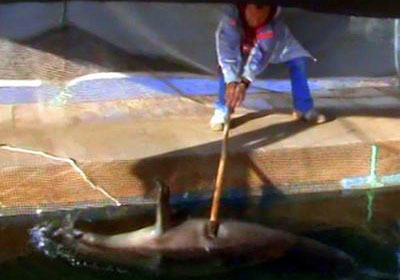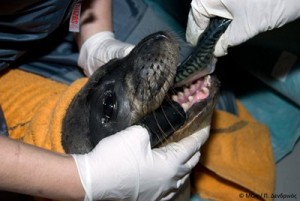 In a brief announcement on its Facebook page, Greek NGO MOm has announced that monk seal pup ‘Fokion’, currently in rehab on Alonnisos, now weighs more than 40 kilos, eats 5 kilos of fish 3 times per day, and is almost ready for release. Fokion was rescued in February on the island of Syros.
In a brief announcement on its Facebook page, Greek NGO MOm has announced that monk seal pup ‘Fokion’, currently in rehab on Alonnisos, now weighs more than 40 kilos, eats 5 kilos of fish 3 times per day, and is almost ready for release. Fokion was rescued in February on the island of Syros.
Veterinarian fined in monk seal beating case
 According to Turkish press reports, the veterinarian charged with beating orphaned monk seal Badem during an ill-conceived ‘aversion therapy’ programme, has received a court sanctioned fine of 848 TL. (approximately $470). It remains unclear whether the Foça town abattoir vet, Avni Gök, will be banned from future monk seal rehabilitations.
According to Turkish press reports, the veterinarian charged with beating orphaned monk seal Badem during an ill-conceived ‘aversion therapy’ programme, has received a court sanctioned fine of 848 TL. (approximately $470). It remains unclear whether the Foça town abattoir vet, Avni Gök, will be banned from future monk seal rehabilitations.
In response to questions from TMG, Turkish monk seal NGO SAD-AFAG, responsible for Badem’s rescue and on-again, off-again rehabilitation, insisted that it had neither approved nor was aware of the veterinarian’s training regime, video footage of which sparked widespread public anger. While condemning the actions of Gök, AFAG’s Cem Orkun Kirac suggested that the footage had been leaked by local opponents of AFAG rehabilitation projects, and that the veterinarian’s methods had not been inspired by cruelty or malice.
TMG’s opinion is that the training regime applied was at best driven out of ignorance and at worst represents a clear case of inexcusable animal cruelty. While Hawaiian monk seal researchers occasionally employ “aversive conditioning” to drive monk seals away from situations in which they or members of the public are deemed at risk, (1) these are applied within the specific situation in which such action is required, not in an enclosed pool where no such risk exists, and (2) utilise actions such as noise, lights or “waving a palm frond” at the animal — presumably not quite in the same league as beating it with a stick.
We understand that AFAG intends to issue an English language press release on the issue within a matter of days.
Sources: Fok Badem’i döven veterinere para cezası, Radical, 5 March 2012.
Jenkinson, E. M. 2010. Aversive conditioning and monk seal – human interactions in the main Hawaiian Islands: Aversive Conditioning Workshop, Honolulu, Hawaii, November 10-11, 2009. U.S. Dep. Commer., NOAA Tech. Memo., NOAA-TM-NMFS-PIFSC-25, 28 p. + Appendices. [PDF 268 KB]
Age study on Mediterranean monk seals
Recent Publications
![]() Murphy S, Spradlin TR, Mackey B, McVee J and others. 2012. Age estimation, growth and age-related mortality of Mediterranean monk seals Monachus monachus. Endangered Species Research 16:149-163. [PDF 1.4]
Murphy S, Spradlin TR, Mackey B, McVee J and others. 2012. Age estimation, growth and age-related mortality of Mediterranean monk seals Monachus monachus. Endangered Species Research 16:149-163. [PDF 1.4]
ABSTRACT: Mediterranean monk seals Monachus monachus are classified as Critically Endangered on the IUCN Red List, with <600 individuals split into 3 isolated sub-populations, the largest in the eastern Mediterranean Sea. Canine teeth collected during the last 2 decades from 45 dead monk seals inhabiting Greek waters were processed for age estimation. Ages were best estimated by counting growth layer groups (GLGs) in the cementum adjacent to the root tip using unprocessed longitudinal or transverse sections (360 µm thickness) observed under polarized light. Decalcified and stained thin sections (8 to 23 µm) of both cementum and dentine were inferior to unprocessed sections. From analysing patterns of deposition in the cementum of known age-maturity class individuals, one GLG was found to be deposited annually in M. monachus. Ages ranged from 0.5 to 36 yr for females, 0.5 to 21 yr for males and 0.5 to 25.5 yr for individuals of unknown sex. The majority of seals (65%) were considered adults (≥4 yr), followed by juveniles (20%, <1 yr) and sub-adults (15%, 1−3.9 yr). Thirty percent of the aged sample had died from human-related causes, such as accidental entanglement in fishing gear and direct killings. A single-Gompertz growth curve was generated for both sexes using standard length data, resulting in asymptotic values of 212.3 cm for females and 221.8 cm for males. This study represents the first quantitative glimpse of sex-specific growth in monk seals and the age structure of dead individuals in this rare species’ core range.
Pup enters rehab in Greece

A 3-month old male pup, ‘weak, in poor nutritional condition and very dehydrated’ has been rescued on the island of Syros, according to Greek monk seal conservation organisation, MOm. The pup, named ‘Phokion’ by local school students, was evacuated to the organisation’s treatment ‘unit’ in Steni Vala, on the island of Alonnisos on 17 February. Treatment is proceeding under veterinary supervision.
Leaked ‘training’ video sparks anger
A leaked video purporting to show conservationists administering human contact “aversion therapy” to rehabilitated monk seal Badem, has sparked anger and indignation among academics and the general public both in Turkey and abroad.
The video, reportedly dated 3 April 2008, appears to show Badem’s carers hitting the seal repeatedly with a stick in what is assumed to be an effort to instil in the animal a reluctance to approach and interact with humans. TMG has requested clarification from the organisation responsible, the Mediterranean Seal Research Group (AFAG), and hopes to publish its response in due course.
The famous monk seal orphan has been in and out of captivity repeatedly due to her increasingly boisterous — and at times, dangerous — interactions with summer bathers.
The leaked video has appeared in major Turkish media outlets, including Milliyet and CNNTurk.
Monk seal threat to endangered marine turtles
Recent Publications
D. Margaritoulis & S. Touliatou. 2011. Mediterranean monk seals present an ongoing threat for Loggerheads in Zakynthos. Marine Turtle Newsletter 131 (December 2011): 18-23. [PDF 1.4 MB]
![]() […] During the 1994 nesting season, 8 loggerhead turtles were found dead in the wider area of Laganas Bay with injuries attributed to predation by monk seals. The observed injuries, as well as direct observations of the predation events, suggested that monk seals were attacking loggerheads from below, snapping off the posterior plastral scutes and feeding on the turtle’s entrails (Margaritoulis et al. 1996). This unique behavior, not documented anywhere else in the world (Fertl & Fulling 2007), was thought to have been triggered by depleted levels of local fish resources during the same season (Karavellas 1995). […]
[…] During the 1994 nesting season, 8 loggerhead turtles were found dead in the wider area of Laganas Bay with injuries attributed to predation by monk seals. The observed injuries, as well as direct observations of the predation events, suggested that monk seals were attacking loggerheads from below, snapping off the posterior plastral scutes and feeding on the turtle’s entrails (Margaritoulis et al. 1996). This unique behavior, not documented anywhere else in the world (Fertl & Fulling 2007), was thought to have been triggered by depleted levels of local fish resources during the same season (Karavellas 1995). […]
